
The Latin word for the occult is occultus, which means something that is hidden or concealed secretly. The common English usage of the word has come to be referred to as the “knowledge of the paranormal,” versus something that can be measured [1]. So it is considered to be something that is present that cannot be readily described or explained by what we know as the natural sciences, such as physics and chemistry.
The modern definitions describe it as the belief and practice of something that is supernatural, mystical, magical, or paranormal; this includes magic, black magic, witchcraft, sorcery, wizardry, necromancy, devil worship, Satanism, voodoo, mysticism, and various other unexplainable sources.
These beliefs and practices are nothing new and have been around for thousands of years, for as long as society has had some sort of religious beliefs these other sources have existed. Through the many centuries there has been hysteria and punishment for what is different and not understood, usually related to the specific religious order that was dominant at that time.
The act of conducting witch-hunts and trials because of societal panic and upheaval has existed since well before it peaked in Europe, beginning in the 15th century. Women were tortured, burned at the stake, or hung because of fear that they were practicing Satanism and witchery, including in the Americas with the Salem witch trials during 1692 and 1693.
Occultism in film has varied throughout cinematic history. While there are instances of the themes being used before the 1950’ and the drive-in era, it didn’t really become a popular theme until then. Between the 1950’s through the 1970’s when exploitative cinema was popular, the use of occultism as a theme increased dramatically.
The success of films such as Rosemary’s Baby, The Wicker Man, The Omen, and The Exorcist further cemented the desire of the audience to see themes that would shock or scare them. Popularity of the horror genre has continued to grow and resulted in franchises being created that deal with the occult and demonic themes, such as Paranormal Activity, Blair Witch Project, and The Conjuring. There was also the return of the popular cult franchise Evil Dead, with a television show titled Ash vs. The Evil Dead.
This list contains a mix of movies that are considered a cult film for a combination of reasons; they are exploitative and controversial, they did poorly at the box office but have a strong following, they are weird and unusual, they are cheap and campy, and some are somewhere in the middle.
1. Haxan: Witchcraft Through the Ages (1922)
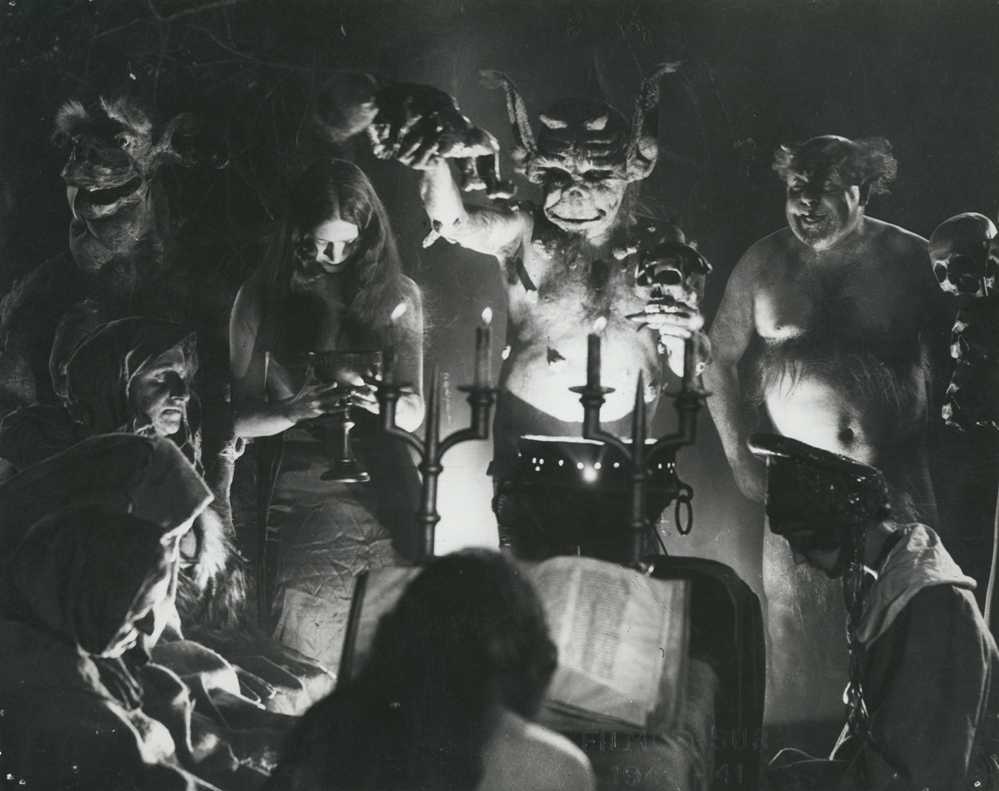
This is a Swedish-Danish produced silent film that is meant to be considered a documentary examining the history and evolution of witchcraft, from its pagan roots through to the hysteria that took place in modernized Europe.
It is shown through a series of vignettes that mix videos with old illustrations and paintings, which include depictions of demons, witches, and Satan performing various acts.
The video vignettes include scenes of witches eating flesh and making love potions, putting spells on men, a group of men performing a ritual on a dead body, multiple appearances of Satan, the Sabbath featuring witches and various demons, witch hunts, and inquisition torture.
It then wraps up in the 1920’s and tries to explain that acts committed by suspected witches of the past were most likely related to mental illnesses. It has a mixture of spooky, unusual, and comedic elements.
There are multiple versions of the film available that have been released. A 76-minute version was released and re-titled in 1968 as Witchcraft Through the Ages, narrated by William S. Burroughs and featuring a soundtrack by Jean-Luc Ponty and Daniel Humair. Criterion released a 104-minute restored version of the film on DVD, featuring the original score performed by the Czech Film Orchestra.
The 1968 version is just great, with the growling and distinct voice of Burroughs narrating the film and the frenetic jazzy beatnik score from Ponty and Humair. Burroughs is a noted novelist and poet associated with the Beat generation, best known for his novel Naked Lunch. It is a difficult film to explain because it falls somewhere between serious and downright campy.
The scenes involving the devil can be described as being hilarious or scary depending on your personal viewpoint. They are reminiscent of the cult film The Forbidden Zone.
There is a pretty memorable scene involving the Sabbath, it’s a huge party with witches, demons, a horse skeleton, Satan, and everyone kissing Satan’s ass at the end. There is also a Benny Hill type scene where a sex crazed monk is chasing a maiden around.
The film is relevant because it was the first film that dealt with witches and witchcraft, while also trying to present it in a factual and historical manner. It has a cult following for both versions among fans of silent films, witchcraft, horror films, and Burroughs fans. If you enjoy any of those, then you should check this out.
2. The Undead (1957)
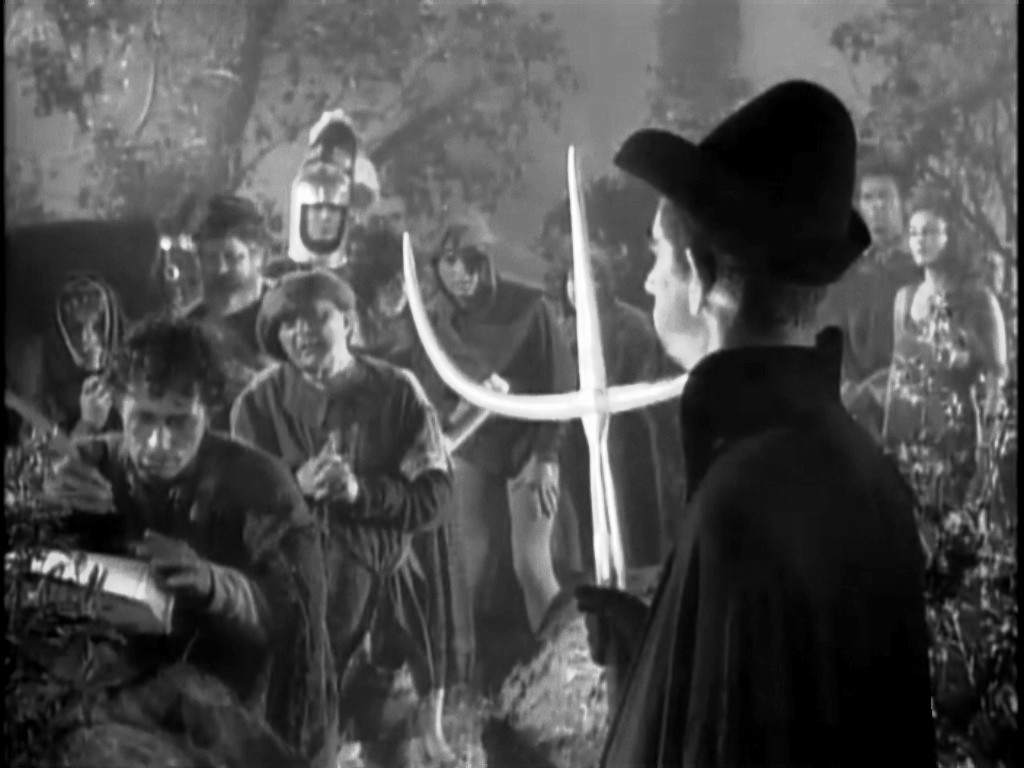
“Terror… that screams from the grave!” [2]. A woman is put into a psychical trance and sent back through time into the body of one of her medieval ancestors, who is condemned to die as a witch. She escapes and a real witch named Livia (Allison Hayes), who works with the Devil, wants her dead so that she can have her boyfriend.
There is also another good witch, an imp that works for Livia, a singing gravedigger, and one of the psychics that travels back in time with her.
Produced and directed by Roger Corman, this is an unusual and fun B-movie that is a mix of horror, violence, reincarnation, time travel, comedy, and campy fun. There is amusing elements with the witch and imp turning into various animals, most notably a pair of very fake looking bats.
The gravedigger is also fun with his songs, rhymes and witty dialogue, such as when he calls the graveyard his “flesh farm.” The devil is great, with his constant laughing and very large pitchfork. On the Sabbath, he summons a trio of dead girls to rise from the grave and do a dance.
The film is most notable for the appearance of actress Hayes and her very tight dress and heaving breasts. Hayes was a very well known B-movie actress of the 1950’s, specifically for her appearance in Attack of the 50 Foot Woman. The film was shot over six days on a budget of $70,000, in an old supermarket that was converted into the sets [3].
It has a cult following among horror, drive-in movies, low budget films, and fans of the cast and crew. If you like any of those, then you should check this out. If you enjoy this film, you may also like The Mole People, Attack of the Crab Monsters, The Leach Woman, The Deadly Mantis, and Premature Burial.
3. Curse of the Demon AKA Night of the Demon (1957)
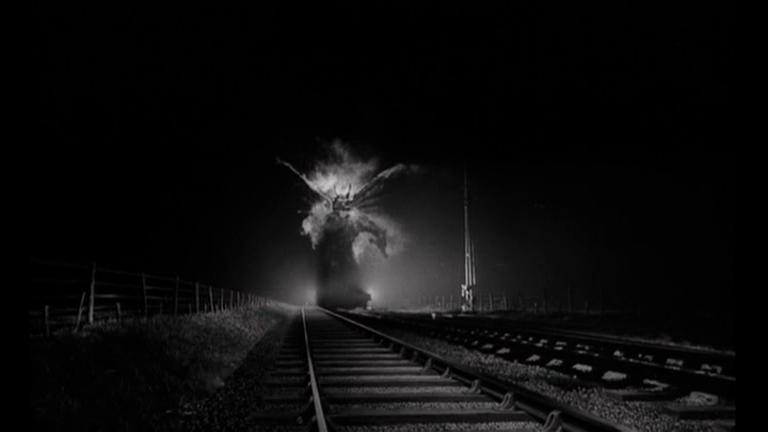
“Horror! Most terrifying story the screen has ever told!” [4]. Paranormal Psychologist Dr. John Holden (Dana Andrews) travels to England in order to investigate and disprove the existence of Satanism and its use by the devil cult leader Dr. Julian Karswell (Niall Macginnis). Holden is supposed to meet with several other Professors, primarily Professor Harrington.
When he arrives he discovers that Harrington has been killed when he crashed his car into an electrical pole and electrocuted himself. Holden does not know that a demon that Karswell conjured had actually killed him. Holden meets with Karswell and he slips him a parchment that is a death curse, a fire demon used to destroy enemies.
Holden also meets Joanna Harrington (Peggy Cummins), the dead professor’s niece, and they investigate the details regarding her uncle’s death and whether the paranormal elements are real. A series of strange occurrences eventually lead Holden to believe that he must pass the parchment back within two days in order to break the curse.
This is a top class British produced psychological thriller with a great cast and script that focuses more on the mood and suggestion as opposed to graphic horror scenes. The three main actors are all excellent in their respective characters. Andrews plays the skeptical professor who only believes in logic and what can be seen and shown to him, finally believing in the demonic curse and witchcraft before it is too late.
Macginnis is absolutely amazing as Karswell, playing the evil cult leader as mostly calm and unassuming. He’s confident and wants Holden to know that the witchcraft is real, giving several demonstrations of his powers throughout the film. He rarely appears menacing in the film and that is the brilliance of his portrayal of the bad guy.
His character is supposed to be a representation of real life Satanist Aleister Crowley, including the pointy goatee [5]. Cummins is also good in her role, playing the role of the believer trying to convince Holden that something evil is going on and that he’s in danger.
There are two versions of this movie. The British release is called Night of the Demon and had a running time of 96 minutes, while the American version was released as Curse of the Demon and had a running time of 81 minutes. There were a lot of production issues between the director and producer, most notably whether or not to show the actual demon on screen. Most of the demon shots were done after the director was done with the production.
In an interview from director Jacques Tourneur, he said that “The scenes in which you really see the demon were shot without me. All except one. I shot the sequence in the woods where Dana Andrews is chased by a sort of cloud. This technique should have been used for other sequences. The audience should never have completely seen the demon….They ruined the film by showing it [the demon] from the very beginning.”
In a different interview Tourneur explained, “I wanted, at the very end, when the train goes by, to include only four frames of the monster…but after I had finished [the film] and returned to the U.S., the English producer made that horrible thing [the monster]” [6].
If you enjoy psychological horror, or films about demons and witchcraft, then you should definitely watch this one.
4. Black Sunday (1960)
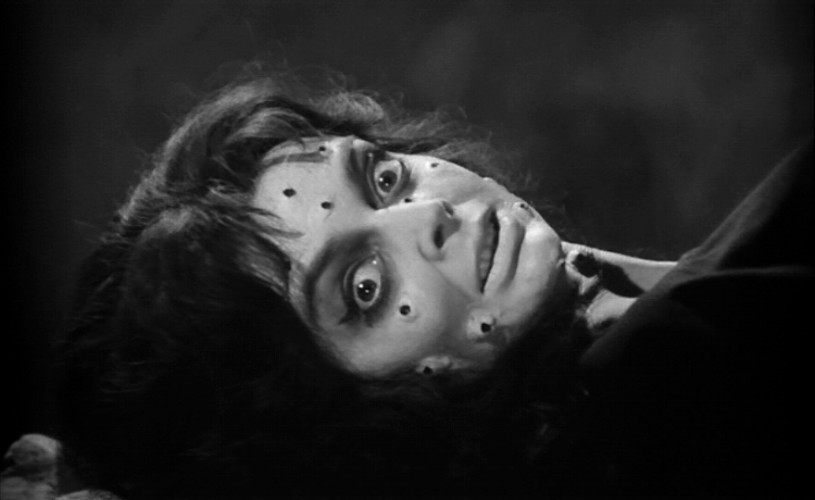
In 1630 Moldavia, the witches Asa Vajda (Barbara Steele) and Javuto are sentenced to death by Asa’s brother and the inquisition. She puts a curse on her ancestors and vows to return and avenge her death. She is tortured, branded with the letter “S” for Satan, and has an iron mask nailed to her face. She is buried in a casket with a glass panel and a cross on the outside, to prevent her from escaping.
Two hundred years later she rises back from the dead, when a pair of doctors discovers the tomb and accidently break the cross and glass panel. One of the doctors cuts himself on the glass and his blood regenerates the witch. She summons Javuto with the plan of draining the blood of her relative, Princess Katia (also played by Steele), in order to gain immortality.
This is an Italian produced gothic horror that is considered to be one of the great masterpieces of horror cinema. It uses a mix of atmosphere, sound, gore, and its gothic surroundings to create a creepy horror film. It is reminiscent of the great black and white horror films of the 1930’s like Dracula, and would go on to influence the British Hammer horror films that would follow.
It is notable for being the directorial debut of Mario Bava and actress Barbara Steele, both of which are mostly associated with the horror genre. Bava would go on to direct the notable films Black Sabbath, The Whip and the Body, Blood and Black Lace, Kill Baby, Kill, A Bay of Blood, and Lisa and the Devil.
Steele became known for her striking beauty, large eyes, and dark hair and appeared in many horror films including Pit and the Pendulum, The Horrible Dr. Hichcock, The Ghost, Castle of Blood, An Angel of Satan, and Curse of the Crimson Altar. Steele does well in her portrayal of the duel characters, switching facial expressions from the innocent Princess to the evil witch.
There are many memorable scenes, including the opening where the witch is tortured and killed. There are great close up shots of the iron mask and the nails inside of it, while switching back to shots of the witch as the mask gets closer to her. Then there is a graphic scene as they hammer the mask onto her face and blood oozes out.
There are also several good scenes when they pull the mask off of her and scorpions come out of her empty eye holes, then several scenes showing her regenerating. There is also a good scene where Javuto rises out of the grave that he is buried in, with the mask still nailed to his head.
The film was loosely based upon a Russian short called The Viy, which would later receive a Russian adaptation titled Viy (1967) that was faithful to its source material [7]. The exterior and some interior scenes were shot at the Scalera Film studios, while the rest of the interior scenes were shot in a castle in the town of Arsoli, Italy [8].
It faced multiple ratings and censorship issues in various countries, including England and the United States [9]. It was outright banned in England and the U.S. version was cut by three minutes, so there are various versions of the film floating around with the gorier scenes trimmed or completely cut [9].
The film was a modest success in Italy and the United States, but it received mostly good critical reviews and has a strong cult following among horror fans [8].
This is one of the monumental horror films and should be considered essential viewing for fans of the genre.
5. Manos, The Hands of Fate (1966)
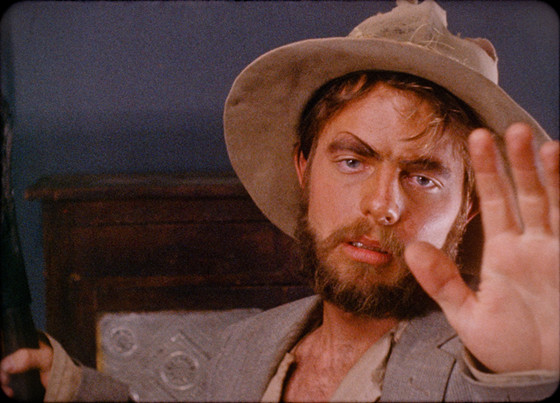
“It’s Shocking! It’s Beyond Your Imagination!” [10]. It’s shockingly bad, the king of bad movies. It is considered to be the worst film ever made, making Plan 9 From Outer Space look like an epic masterpiece. It has everything that will please fans of bad movies: terrible acting, bad lighting, bad and laughable dialogue, unbelievable situations, bad lighting, and bad special effects.
The story involves a family that gets lost while on vacation and ends up staying at a house that contains a satanic cult, featuring a Freddy Mercury lookalike cult leader, six wives, and an evil henchman named Torgo who has big knees.
The film was shot on a budget of $19,000 [11]. At times it feels like you’re watching a silent film, with just the scored music playing throughout. There are times when the actors are speaking without dialogue. The editing is so choppy because it was filmed using a 16mm Bell & Howell camera, which can only take 32 seconds worth of footage at a time [11].
All audio was dubbed later in a sound studio, with most of the voices being dubbed by just two people [11]. The lighting is so bad that it attracted all of the bugs that you can see on camera. There is also a scene where you can see the film clapboard on the right hand side.
It was able to get distribution but didn’t do anything and was pretty much forgotten until its appearance on season four of Mystery Science Theater 3000. That episode containing Manos is considered one of the best of the series and brought back a new cult following to this wonderfully bad film [12].
So if you’re a fan of bad movies, then this one’s for you.
6. The Witches (1966)
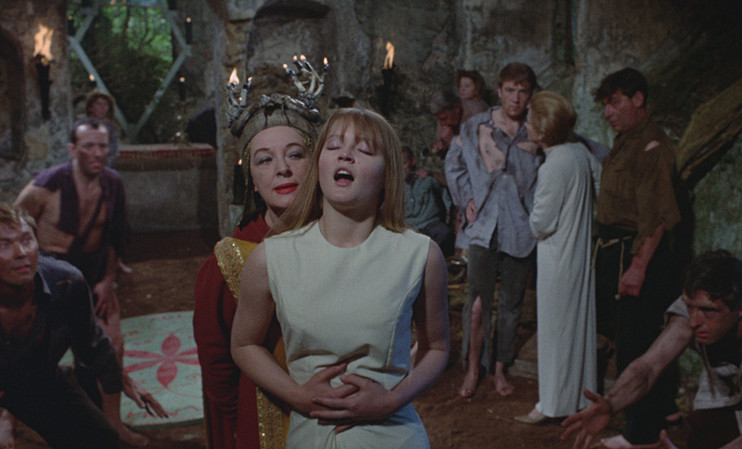
“A STRANGER IN A TOWN THAT HAS LOST ITS MIND …IF SHE’S NOT CAREFUL, SHE MAY LOSE HER’S TOO!” [13]. Gwen Mayfield (Joan Fontaine) is on a missionary trip in Africa when she encounters an event by practicers of voodoo and suffers a nervous breakdown. She returns to England and takes a teaching position in a small town, hoping to recover from her traumatic experiences.
She starts to discover strange occurrences happening in the town; a girl who has her hand mangled, a cat following her around, a boy in a coma, a voodoo doll with pins in it, the boy and his mother leave town after a talk with one of the old ladies, the father of the boy drowns, she gets trampled by a group of sheep, she relapses after seeing the voodoo mask that was in Africa. All of these events lead her to discover that there is a coven of witches who plan to sacrifice a virgin girl for one of their rituals.
The film is a British horror film produced by Hammer Films, who became well known for their horror films from the 1950’s to 1970’s. It is based upon the novel The Devil’s Own by Norah Lofts. The film is more story driven and is a slow burn, as weird things slowly happen to the teacher in her new surroundings and she starts to put the pieces to the puzzle together.
The final twenty minutes of the film are what is most memorable as we discover the truth of what is going on in this town. Fontaine delivers a strong performance in her final appearance in a starring role. She is known for appearances in Rebecca, Suspicion, This Above All, and The Constant Nymph.
There is imagery that stands out in the film. The large voodoo mask that Mayfield first sees when she is in Africa, when the Africans break into the village. It then reappears in a scene when she is in England and forces her back into a hospital.
There is also the scene where she is trampled by the sheep and falls into the mud, which was considered unusual to see a star have a stunt like that happen to them. It is also notable for featuring a female protagonist and a female antagonist, with the main male character portraying a weak powerless almost feminine role.
This is a fairly forgotten gem from Hammer studios, often passed over for the Dracula series and other films. If you’re a fan of Hammer Films, horror, or witchcraft, then you should watch this. If you enjoy this, you may also like The Devil Rides Out, Dracula: Prince of Darkness, To The Devil a Daughter, and The Wicker Man.
7. Something Weird (1967)
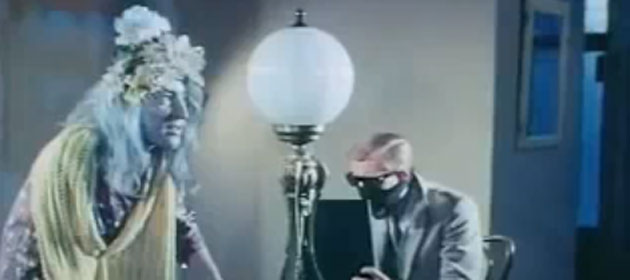
“A boiling, bizarre tale of a mad love that crashes through the supernatural!” [14]. A man disfigured from a falling electrical line makes a deal with a witch to restore his looks; in return he must agree to become the witch’s lover. Oh and he also has psychic powers now.
They travel from city to city like Kane from Kung Fu solving crimes, including getting rid of a ghost and finding a serial killer. This mad film also includes a weird mix of sex, murder, LSD, psychedelic lighting and effects, karate, séances, federal agents, and a smooth jazz score. Add the mix of bad acting, overacting, cheap costumes, and you have a great low budget film.
This was directed by Hershell Gordon Lewis, who was known for low budget exploitative films such as Blood Feast, Two Thousand Maniacs, The Wizard of Gore, Color Me Blood Red, and The Gruesome Twosome.
Just like this and most of his other films, they are all usually “uneven, disgusting and offensive in places, amusing in others, with their principal virtue as a group of films probably their rough-hewn naivety” [15]. The budget was estimated to be around $35,000 [14].
If you love exploitation, horror, gore, or cheap movies, then you should watch this. You may also enjoy The Wizard of Gore, I Drink Your Blood, and the Gruesome Twoesome.
8. The Conqueror Worm AKA Witchfinder General (1968)
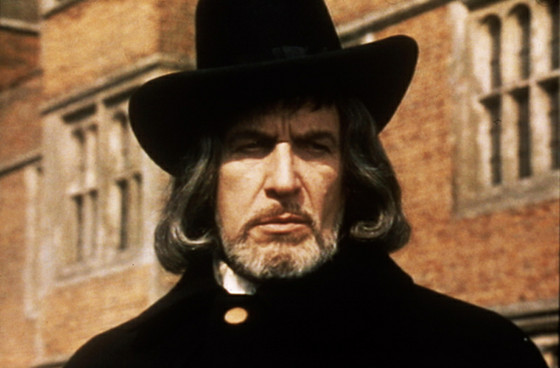
“The Year’s Most Violent Film!” [16]. In 1645, England is going through a civil war and there is social and political upheaval. This is causing conflicts in local towns as men take advantage of this and they are able to gain power by exploiting superstitions of witchcraft.
One such man is the witch hunter Matthew Hopkins (Vincent Price), who tours the countries small towns torturing confessions out of the suspected witches. He also abuses his powers for sexual acts and financial gain. When a priest is persecuted and hung by Hopkins, his niece’s fiancé vows to track him down and murder him.
The film is a grim and realistic take on what took place during that time, featuring multiple scenes of violence, torture, murder, and rape. The film is notable for multiple reasons. It features a fine performance by Price as the villainous Hopkins who acts as if he knows that his bizarre witch tests are frauds, but does the job for the perks as opposed to a belief of moral justice.
It was directed by Michael Reeves, who was considered a “brilliant but troubled young director whose potential was cut short…when…an accidental overdose of barbiturates killed him [at 25]” [17]. He would only complete three films, including She Beast, and The Sorcerers.
The film is based upon a 1966 novel titled Witchfinder General by Ronald Bassett, which was written about an actual historical figure by the same name.
Donald Pleasance was originally wanted by the director to play Hopkins, but when American International Pictures got involved they requested that their contracted star Price have the lead [18]. Reeves and Price had issues throughout the production and often clashed, in one instance Price had an issue with a suggestion the director had made and told him that “”I’ve made 87 [sic] films. What have you done?” And Reeves responded: “I’ve made three good ones. Reeves hated me,”
Price later recalled. “He didn’t want me at all for the part. I didn’t like him, either. It was one of the first times in my life that I’ve been in a picture where the director and I just clashed”.
Price felt that all the actors on the set had a difficult time with the director, explaining: “Michael Reeves could not communicate with actors. He would stop me and say, ‘Don’t move your head like that.’ And I would say, ‘Like what? What do you mean?’ He’d say, ‘There — you’re doing it again. Don’t do that’.” Price reportedly became so upset with Reeves that he refused to watch the film’s dailies” [19].
The film’s name was changed for American distribution to The Conqueror Worm, in order to coincide with Price’s Edgar Allen Poe films. It did average numbers in America, earning $1,500,000 [16].
It has maintained a cult following because of the director’s untimely death, horror fans, witchcraft fans, and fans of Vincent price. If you enjoy any of those then you should check this out, it is considered a solid British horror classic.